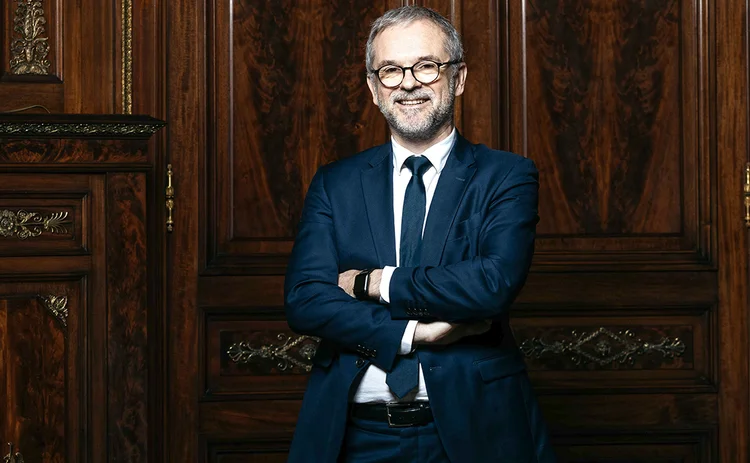The Change Manager: Fabrice Silberzan, BNP Paribas Asset Management
Fabrice Silberzan is playing a key role in the transformation of BNP Paribas Asset Management. With his background working across different cultures and various roles, from IT to securities and HR, the opera-loving Frenchman has a lot of lessons to share in change management.

It’s fair to say that Fabrice Silberzan, COO of BNP Paribas Asset Management, is a well-traveled man. Over the course of his career, he’s worked in traditional banking mainstays in Europe and the US, but also the Far East, the Middle East and everywhere in between. From Britain to Bahrain, he’s come to a conclusion about the markets business: While technology is important, the real capital in banking worth a dime is its human capital. Learning how to manage that is the crucial difference between success and failure.
“There are many technologies,” he says, “You can decide which technologies are most effective. But there is one factor that I think has been, and will remain, more promising than any technology in the world and that is people. Whatever technology you choose, human capital will be the most important differentiating factor.”
It’s a common refrain heard from C-level executives in the pages of this magazine, but it’s wisdom that is often hard-won. Silberzan is no different—indeed, he recalls a tricky project in 2003, where he had to roll out a money transfer system across Europe. The system worked, he says, but the real problems lay with figuring out the regional idiosyncrasies and requirements of the staff who were assigned to the project, all of whom sought—and, crucially, interpreted—guidance on different levels.
In other words, technology problems are often, at root, people problems—and more specifically, communication and management problems. “One of the things I learned with BNP Paribas, and I am grateful to them for providing me with the opportunity, is how wonderful it is to work with different cultures. But you need to understand the implicit, that is what is not said, is different from what is said. We don’t all don’t come from the same place and people expect different interactions.”
The key, Silberzan says, is listening more. It’s an outlook he’s tried to implement over a three-decade career at the French bank, which has seen him cross both sides of the Street in more ways than one.
Early Days
Born and raised in Villeneuve-Saint-Georges, a suburb of Paris, and despite early intentions to be a doctor as a 10-year-old boy, Silberzan quickly gravitated toward finance, after a brief flirtation with engineering ambitions.
He studied mathematics and IT at École Nationale Supérieure des Mines de Nancy. One area he specialized in was operations research, a field very much oriented toward statistics, which gave him a chance to look at how processes could be implemented in an efficient and effective manner. He also studied a lot of mathematics, statistics and programming, which was particularly focused on the C and Pascal languages. He completed his masters with a qualification of Ingenieur Civil des Minesin in 1990.
Post-university wanderlust led Silberzan to look for a job abroad and away from France—even his alma mater, in the city of Nancy, is a mere 90 minutes from the French capital by train. He soon came across an opportunity to work for Banque National de Paris—which would later become BNP Paribas—based in Norway, in 1991. That, he recalls, was kismet. He had applied to work abroad, and the bank needed a candidate willing to relocate. “It was really, I would say, an opportunistic moment, how it happened,” he says. After all, 28 years later, he is still with the company.
For the first six months in the role, he was his own boss. There was only one other person in the IT department in Norway at the time, eventually growing into a small IT team with Silberzan at its helm. It was one of his first brushes with the differences in culture between colleagues—people in Norway, he recalls, had a very strong sense of work–life balance, while his tasks varied from the menial—like changing the paper in the printer—to coding software for the bank’s back office.
This was also a massive learning curve for him in terms of his professional development. The internet was nowhere near ubiquity, and computing was still at a basic level relative to what it is today—he recalls his first PC was a Dell with a hard disk storage capacity of just 40 megabytes. Still, the education in the banking industry was first rate, not least of all when BNP acquired a Norwegian bank, Kjøbmandsbanken. And he found himself working in all areas of the business.
For Silberzan it was like a school. “I learned banking there because it was quite a small shop—like 100 staff,” he says. “But we were doing everything from an automatic teller machine to trading on another floor of the building, from cooperative banking to wealth management.”
After four years in Norway, he returned to France and joined BNP’s Inspection Générale department, where the firm’s auditing is carried out. Silberzan began working as an inspector, and two years later was appointed to the role of head of assignments. He would lead audits with teams to different corners of the world, from Asia to the Americas. In this role, he was able to see and audit different aspects of the organization, becoming involved in everything from investment banking to retail. “It was very international, very diverse, and my job was to look at what was done and to consider whether it was [done] appropriately or not,” he says.
After four years in the role, he was appointed head of cash management products and services in 1999. For someone with his background, it was perfect, as this was an area where technology and banking were becoming intertwined. “Technology started to be meaningful for banking and finance,” he says. “It was the beginning of algorithmic trading, for example. For cash management it was the moment when our technological capacity would mean something to our client.”
The Promise of Technology
The late 1990s were still early days for the internet but technology was moving fast. Silberzan spent a lot of time proposing new solutions to clients, and he was becoming acutely aware that technology never stopped changing. “It was the first internet bubble,” he says. “You were always behind something new that had happened, and that a competitor potentially was using, or said it was using. We couldn’t spend one day without a vendor coming, just like today, and telling you that you were making the biggest mistake in your life because we were not using the technologies that were proposed that would make you the king of the world.”
Silberzan made another move within a few years, being appointed as the head of clearing and market operations in 2002, a move that also saw him transition to the Securities Services arm of the bank, where technology was most effective. Its systems handled billions of dollars’ worth of assets being traded, and reliability was key. This was put to the test when Lehman Brothers failed during the 2008 financial crisis, and the markets were sent into turmoil.
Silberzan learned a lot during that time, namely that in a time of stress and volatility in the markets, it is necessary to react as a team, and a manager has to bring calm and sound decision-making to the team so they can carry on with their jobs. It is not a time to defend oneself. In these kinds of crisis moments, he learned it was imperative to speak with colleagues and swiftly make the right decisions.
Although he was head of clearing, Silberzan looked after multiple teams in operations. After eight years on the front lines of the crisis, he was made head of human resources (HR) at BNP Paribas Securities Services in 2010, and stayed in the role for five years. His role included activities like workforce planning, personal development and strategic sourcing. Then, in 2015, he was offered the opportunity to join BNP Paribas Asset Management as it embarked on a period of transformation. For Silberzan, while his background was firmly on the sell side, it still felt like going home. He had spent five years in HR, but 20 years dealing with IT, operations and auditing—which dealt with many of the same matters.
The Change-Maker
As he joined the buy-side arm of the bank, change was underway. On the technology front this included working on enhancing its quantitative capacity as well as combining more quant research and quantitative asset management. It also included partnerships with fintechs in areas like smart coding, robo-advice and artificial intelligence.
For the past 18 months, the asset management firm has been implementing a new end-to-end front-office system that will combine risk analytics, portfolio management and transaction trading into one system. In addition to its enhanced scope, it will also have the benefit of replacing around 50 legacy applications that are costly to maintain. Silberzan describes it as changing a large group—complicated to integrate and costly to maintain—into one, wider enterprise. The project is being implement with BlackRock’s Aladdin and is expected to go live in May.
“Each of the numerous systems we were using were good but the sum of them created a complexity,” he says. “We had to manage several views of the same position that we had to reconcile at all times. That is why we are now implementing one single source of truth across the organization. This is transformational.”
Other tech initiatives are firmly underway. He says what the asset management sector is missing is more standard reporting capacity. One example of this is around Solvency II, where Silberzan notes that everyone has developed their own ways to report. “We all have to invent our own manner of formatting our elements,” he says. He says there could be room for better cooperation within the industry.
But one of the most transformational technologies for the bank is cloud, which has historically been tricky to implement at large firms such as BNP Paribas Asset Management. Silberzan appreciates the ability to implement new software and developments faster. A growth in data means paying more, but if the data decreases, it costs less.
However, concerns around data privacy mean BNP Paribas is looking at public cloud very carefully. As the firm gets cloud-ready, he estimates implementation will take place in two years. “We are preparing all our information and all our architecture to be cloud-ready. A large part of our information system will be cloud-based. Will everything be cloud based? We don’t believe so. I mean, not in the very near future. But a very large part of it will.”
The move to cloud will also democratize opportunities for collaboration between banks and fintech firms. “I believe it is competition to some extent,” he says. “But there is also a cooperation element. We work with 10 different fintechs. Sometimes it works, sometimes it doesn’t work.” In certain cases the relationship has developed further, such as BNP Paribas’ acquisition in 2017 of Belgian fintech firm Gambit, which specializes in robo-advisory.
More Than a One-Man Show
The bank is also exploring other emerging technologies such as distributed ledger, or blockchain. In 2017, the asset manager carried out its first blockchain transaction, but there is still some way to go before it becomes more prevalent. Silberzan says blockchain can enhance transactions around subscriptions, redemptions and other areas of asset management.
Blockchain is as much a protocol as a technology, he notes. A technology can be implemented by one party, but a protocol requires at least two to interact. Silberzan says the asset manager is considering opportunities in the market, but says it’s not a one-man show.
“I don’t believe it will be one asset manager who will have a ‘clean’ blockchain solution,” he says. “It is more about finding the right partnership across the industry that can aggregate a sufficient number of asset managers and distributors so that we can then start working on large-scale change in the industry to implement blockchain.”
As a prime use-case, Silberzan points to the implementation of blockchain in document management, where a shared golden source is needed.
There have been a number of well-publicized initiatives by bank consortiums working on blockchain technology. But the asset management industry is different. Silberzan says the banking industry has always been better at organizing itself as an industry. “Asset management is an industry that is not used to sharing infrastructures,” he says. “Whether you want it or not, at some stage you will need someone to operate blockchain. I think the solution will come.”
Disrupting Traditional IT
One of the fundamental changes at the firm since Silberzan’s tenure as COO has been the way work is performed when it comes to technology implementation. The digital team at the asset manager reports to the product organization, which is a provider of not only ideas but technology solutions that will eventually be made at scale by the more traditional IT team, which is also working very closely with them. This is an approach the asset manager has developed into its organization where it picks personnel who are not necessarily technology native, but who are incredibly smart, who can pick up whatever technology exists and help to introduce opportunities for the business.
“When you come only from a ‘traditional’ technology background you may remain slightly conservative,” he says. “When you have a ‘single and traditional’ IT team you may be tempted to always leverage more of the same, whereas sometimes you need disruptions. We need in our organization to get places where disruption comes. And they need to have leverage.”
He points to marketing and product engineering as areas that can be disruptive for IT. “The closer you can get product people to the traditional IT world, the better the result you will have,” he says. “People will come without the feeling that prevailed before. This generation will not be afraid, to search in the internet and say ‘oh, there is this technology, it seems incredibly interesting, why shouldn’t we try it?’ And they will try. They will either ask you to try or they will be pushing you all the time to look at the wider open world and to better consider the possibilities that are out there. And this is where you start being disruptive.”
He says technology is not the sole property of IT. “Technology is now everywhere in the organization and in the mind of everyone,” he says. “The head of marketing thinks technology. The head of client experience thinks technology. For the head of product it is also about technology.”
In his free time Silberzan enjoys sports, cooking and music. He listens to classical music, especially opera, naming Bellini and Mozart among his favorites. He also likes Bob Marley and The Rolling Stones and also enjoys singing himself.
The transformation the asset manager began around the time Silberzan became COO is still ongoing. It is working on improving not only the client journey, but also enhancing quantitative capacity as well as combining more quant research with quantitative asset management. Silberzan likens it to building a new investment firm, at the core of which, ultimately, is the people who staff it. He says he is proud to see individuals in his teams grow and that, at times, he feels like a football coach. At the end of the day, he is not the one on the field, and the way he sees it, none of what is done in this organization is about him. It is the team that wins.
Only users who have a paid subscription or are part of a corporate subscription are able to print or copy content.
To access these options, along with all other subscription benefits, please contact info@waterstechnology.com or view our subscription options here: http://subscriptions.waterstechnology.com/subscribe
You are currently unable to print this content. Please contact info@waterstechnology.com to find out more.
You are currently unable to copy this content. Please contact info@waterstechnology.com to find out more.
Copyright Infopro Digital Limited. All rights reserved.
As outlined in our terms and conditions, https://www.infopro-digital.com/terms-and-conditions/subscriptions/ (point 2.4), printing is limited to a single copy.
If you would like to purchase additional rights please email info@waterstechnology.com
Copyright Infopro Digital Limited. All rights reserved.
You may share this content using our article tools. As outlined in our terms and conditions, https://www.infopro-digital.com/terms-and-conditions/subscriptions/ (clause 2.4), an Authorised User may only make one copy of the materials for their own personal use. You must also comply with the restrictions in clause 2.5.
If you would like to purchase additional rights please email info@waterstechnology.com
More on Emerging Technologies
Waters Wavelength Ep. 302: Connectifi’s Nick Kolba
Nick joins the show to give his views on trends in the interoperability space and the FDC3 standard.
AI co-pilot offers real-time portfolio rebalancing
WealthRyse’s platform melds graph theory, neural networks and quantum tech to help asset managers construct and rebalance portfolios more efficiently and at scale.
Waters Wavelength Ep. 301: SIX’s Javier Hernani
Javier Hernani, head of securities services at SIX, joins to discuss everything T+1.
Bloomberg debuts GenAI news summaries
The AI-generated summaries will allow financial professionals to consume more data, faster, officials say.
8 bank CTOs and CDOs sound off on artificial intelligence
Waters Wrap: Last year, WatersTechnology spoke with heads of technology and data from a range of tier-1 banks. Anthony pulls at one common thread from those interviews: AI.
Waters Wavelength Ep. 300: Reflecting on humble beginnings
It is our 300th episode! Tony and Shen reflect on how it all started.
An inside look: How AI powered innovation in the capital markets in 2024
From generative AI and machine learning to more classical forms of AI, banks, asset managers, exchanges, and vendors looked to large language models, co-pilots, and other tools to drive analytics.
Asset manager Saratoga uses AI to accelerate Ridgeline rollout
The tech provider’s AI assistant helps clients summarize research, client interactions, report generation, as well as interact with the Ridgeline platform.





